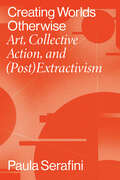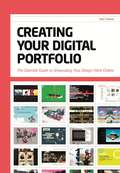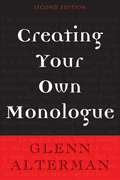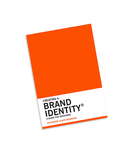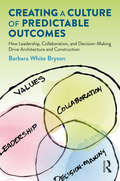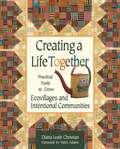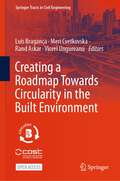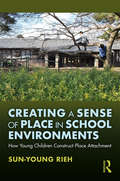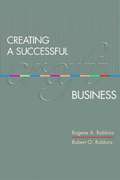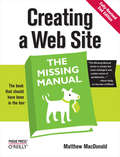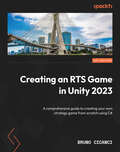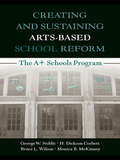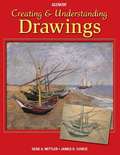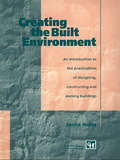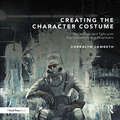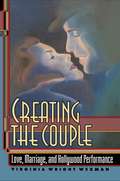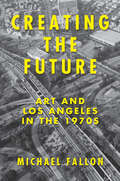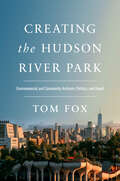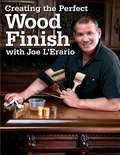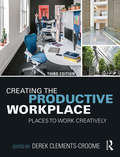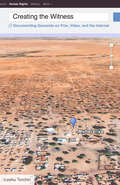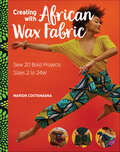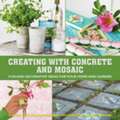- Table View
- List View
Creating Worlds Otherwise: Art, Collective Action, and (Post)Extractivism (Performing Latin American and Caribbean Identities)
by Paula SerafiniExtractivism has increasingly become the ground on which activists and scholars in Latin America frame the dynamics of ecological devastation, accumulation of wealth, and erosion of rights. These maladies are the direct consequences of longstanding extraction-oriented economies, and more recently from the expansion of the extractive frontier and the implementation of new technologies in the extraction of fossil fuels, mining, and agriculture. But the fields of sociology, political ecology, anthropology, and geography have largely ignored the role of art and cultural practices in studies of extractivism and post-extractivism. The field of art theory, on the other hand, has offered a number of texts that put forward insightful analyses of artwork addressing extraction, environmental devastation, and the climate crisis. However, an art theory perspective that does not engage firsthand and in depth with collective action remains limited and fails to provide an account of the role, processes, and politics of art in anti- and post-extractivist movements.Creating Worlds Otherwise examines the narratives that subaltern groups generate around extractivism, and how they develop, communicate, and mobilize these narratives through art and cultural practices. It reports on a two-year research project into creative resistance to extractivism in Argentina and builds on long-term engagement working on environmental justice projects and campaigns in Argentina and the UK. It is an innovative contribution to the fields of Latin American studies, political ecology, cultural studies, and art theory, and addresses pressing questions regarding what post-extractivist worlds might look like as well as how such visions are put into practice.
Creating Writers: A Creative Writing Manual for Schools
by James CarterThis unique and comprehensive text offers an original approach to teaching creative writing by exploring ideas, giving advice, and explaining workshop activities and has many contributors from some of today's most popular children's authors including: Jacqueline Wilson, Roger McGough, Philip Pullman, Malorie Blackman and David Almond.Creating Writers is a practical writing manual for teachers to use with upper primary and lower secondary level pupils that covers poetry, fiction and non-fiction.
Creating Your Digital Portfolio: The Essential Guide to Showcasing Your Design Work Online
by Ian ClazieThis book will help graphic designers, illustrators, and other creative professionals navigate the challenge of creating a digital portfolio. It contains practical advice to getting your work into a portable digital format ready to share on the web. It also discusses the thinking behind creating a portfolio, your objectives, and communication strategy.
Creating Your Own Monologue
by Glenn AltermanIn the second edition of this popular guide, actors learn to use their skills to write monologues, performance art pieces, and one-person plays. Updated to include exclusive interviews and tips on marketing, this guide helps actors create their own exciting performance opportunities and follow in the footsteps of Elaine Stritch, Billy Crystal, John Leguizamo, and other stunningly successful writer-performers of one-person shows. The author, an award-winning actor, breaks down the writing process into simple steps, coaching the reader through each stage of the creative journey.
Creating a Brand Identity: A Guide for Designers
by Catharine Slade-BrookingCreating a brand identity is a fascinating and complex challenge for the graphic designer. It requires practical design skills and creative drive as well as an understanding of marketing and consumer behaviour. This practical handbook is a comprehensive introduction to this multifaceted process.Exercises and examples highlight the key activities undertaken by designers to create a successful brand identity, including defining the audience, analyzing competitors, creating mood boards, naming brands, designing logos, presenting to clients, rebranding and launching the new identity.Case studies throughout the book are illustrated with brand identities from around the world, including a diverse range of industries – digital media, fashion, advertising, product design, packaging, retail and more.
Creating a Brand Identity: A Guide for Designers
by Sue JenkynCreating a brand identity is a fascinating and complex challenge for the graphic designer. It requires practical design skills and creative drive as well as an understanding of marketing and consumer behaviour. This practical handbook is a comprehensive introduction to this multifaceted process.Exercises and examples highlight the key activities undertaken by designers to create a successful brand identity, including defining the audience, analyzing competitors, creating mood boards, naming brands, designing logos, presenting to clients, rebranding and launching the new identity.Case studies throughout the book are illustrated with brand identities from around the world, including a diverse range of industries – digital media, fashion, advertising, product design, packaging, retail and more.
Creating a Culture of Predictable Outcomes: How Leadership, Collaboration, and Decision-Making Drive Architecture and Construction
by Barbara White BrysonCreating a Culture of Predictable Outcomes demonstrates the importance of creating cultures in the design and construction industries grounded in sophisticated-caring leadership, high-performing collaborative teams, and master-level decision-making discipline, informed by values, to finally address massive inefficiencies, waste, and unpredictability. Barbara White Bryson offers specific guidance to industry stakeholders to succeed in achieving project-related predictable outcomes by focusing on culture rather than process. This includes selecting the right team members by hiring and firing bravely, valuing psychological safety, leading with values, practicing respect and transparency, fostering empowerment to make decisions at the right level at the right time, and more. This book is a must-read for design and construction professionals who want to finally understand how to set goals and meet those goals for their clients as well as for their teams.
Creating a Life Together
by Patch Adams Diana Leafe ChristianCreating a Life Together is the only resource available that provides step-by-step practical information distilled from numerous firsthand sources on how to establish an intentional community. It deals in depth with structural, interpersonal and leadership issues, decision-making methods, vision statements, and the development of a legal structure, as well as profiling well-established model communities. This exhaustive guide includes excellent sample documents among its wealth of resources.Diana Leafe Christian is the editor of Communities magazine and has contributed to Body & Soul, Yoga Journal, and Shaman's Drum, among others. She is a popular public speaker and workshop leader on forming intentional communities, and has been interviewed about the subject on NPR. She is a member of an intentional community in North Carolina.
Creating a Roadmap Towards Circularity in the Built Environment (Springer Tracts in Civil Engineering)
by Viorel Ungureanu Luís Bragança Meri Cvetkovska Rand AskarThis open access book summarizes the research being pursued as part of the COST Action CA21103 titled "Implementation of Circular Economy in the Built Environment" (Circular B), which aims to define the methodology to develop a common circularity framework for inclusive application and assessment in new and existing buildings to support decision-making for all value chain stakeholders and appraise the implementation level of the European Circular Economy Action Plan (CEAP). The Action is increasingly gaining interest worldwide, bringing multidisciplinary young and experienced researchers together to share the latest studies and develop new knowledge. Consisting of 17 chapters corresponding to the conference themes, the book analyses and discusses topics such as Circular Economy (CE) best practices, design strategies for circular buildings, circular materials and products, adaptive reuse of existing buildings, recovery and reuse of salvaged materials and products, case studies of current applications and trends, barriers against CE implementation in buildings, efficient waste and circular resource management, circular lifecycle management and decision making, stakeholders relationships, CE supporting policies and barriers, circular business models, criteria, KPIs and assessment models for circular buildings, CE criteria in sustainability frameworks, digitalization and BIM for enhanced circularity of buildings and building materials, and standardization of CE definitions in buildings.
Creating a Sense of Place in School Environments: How Young Children Construct Place Attachment
by Sun-Young RiehCreating a Sense of Place in School Environments guides its readers to the characteristics that tend to generate a sense of place through children’s vivid descriptions of their school and provides a body of critical information that can be employed to design a better school environment that can imprint cherished childhood memories. The childhood school environment calls for special attention regarding the sense of place it creates. The sense of place in childhood both affects children's current quality of life and frames their lasting world view. It is well known that children's cognitive development is closely related to their place attachment to their surroundings, and that children’s adaptation to a given environment depends on how such place attachment can be created. Therefore, it is natural that people’s identity in the world is the accumulation of their experience of place while in childhood. Cross-checking between the imprint of adults' memories of places in school and children’s current "lived experience" of their favorite school place confirmed that certain spatial configurations, which the author herein refers to as "place generators" can generate positive attributes of physical settings that construct a sense of place and last as lifelong memories. It is an ideal read for academics, students, and professionals.
Creating a Successful Craft Business
by Rogene A. Robbins Robert RobbinsFrom writing a business plan and financing an idea to choosing the most cost-efficient production method and best-suited sales approach, Creating a Successful Crafts Business provides a sound blueprint for turning a beloved hobby into a lucrative career. Written by two experienced craftspeople who have been through the trials, tribulations, and triumphs of running a crafts business, readers will learn, step by step, how to negotiate with bankers, choose the ideal retail location, promote the business on-line, expand into lucrative new markets, and much more. Filled with the infectious spirit of people who have "been there," this down-to-earth book will bring fledging craft businesses to new levels of profits and success.
Creating a Web Site: The Missing Manual (Missing Manual)
by Matthew MacDonaldThink you have to be a technical wizard to build a great web site? Think again. If you want to create an engaging web site, this thoroughly revised, completely updated edition of Creating a Web Site: The Missing Manual demystifies the process and provides tools, techniques, and expert guidance for developing a professional and reliable web presence.Whether you want to build a personal web site, an e-commerce site, a blog, or a web site for a specific occasion or promotion, this book gives you detailed instructions and clear-headed advice for:Everything from planning to launching. From picking and buying a domain name, choosing a Web hosting firm, building your site, and uploading the files to a web server, this book teaches you the nitty-gritty of creating your home on the Web.Ready-to-use building blocks. Creating your own web site doesn't mean you have to build everything from scratch. You'll learn how to incorporate loads of pre-built and freely available tools like interactive menus, PayPal shopping carts, Google ads, and Google Analytics. The modern Web. Today's best looking sites use powerful tools like Cascading Style Sheets (for sophisticated page layout), JavaScript (for rollover buttons and cascading menus), and video. This book doesn't treat these topics as fancy frills. From step one, you'll learn easy ways to create a powerful site with these tools.Blogs. Learn the basics behind the Web's most popular form of self-expression. And take a step-by-step tour through Blogger, the Google-run blogging service that will have you blogging before you close this book.This isn't just another dry, uninspired book on how to create a web site. Creating a Web Site: The Missing Manual is a witty and intelligent guide you need to make your ideas and vision a web reality.
Creating an RTS Game in Unity 2023: A comprehensive guide to creating your own strategy game from scratch using C#
by Bruno CicanciBuild real-time strategy (RTS) games using Unity with practical techniques, best coding practices, and popular design patterns in this part-color guideKey FeaturesLearn how to implement game architecture and gameplay featuresExplore unit actions, resource management, physics simulations, and audiovisual enhancements to boost player engagementDiscover RTS mechanics such as implementing melee/ranged battles, unit spawning, dynamic maps, pathfinding, and morePurchase of the print or Kindle book includes a free PDF eBookBook DescriptionBuilding a successful real-time strategy game is challenging, because of both the complex mechanics and the need to strike a balance between different elements, ensuring that players enjoy creating and executing strategies against the game's AI. Creating an RTS Game in Unity 2023 will teach you how to install and set up the Unity game engine, create a new 3D project, and build a level editor to make it easier to modify and add maps to a game. The RTS game will start to take shape while you learn to implement different core systems such as melee and ranged battles, unit spawners, camera controls, dynamic mapping generation, basic enemy AI, and the pathfinder algorithm. You'll also get to grips with implementing command units to perform actions, crafting and producing resources, basic physics and collision detection, and building an RTS game from scratch using C# and the latest features of the Unity game engine. By the end of this book, you’ll be able to make professional and high-quality end-to-end RTS games using the best practices and techniques from the gaming industry.What you will learnIncorporate the most used design patterns, algorithms, and techniques into your gameEmploy the best coding practices used in the games industryExplore the basics of AI and physics to create high-quality gamesBuild dynamic and configurable maps to enhance the player experienceSolve complex problems using the industry standards for Unity and C#Create the mechanics present in classic RTS games using a modern approachGain a deep understanding of how to create professional games using UnityWho this book is forIf you are a beginner game developer who wants to learn the skills to develop a professional RTS game, a programmer looking at career options in the industry who needs to develop a portfolio, or even an indie game developer seeking inspiration for your own games, this book is for you. Professional game developers, programmers with experience in C#, as well as game designers and artists looking for a practical guide to bring their game ideas to life will also find plenty of useful information in this book.
Creating and Sustaining Arts-Based School Reform: The A+ Schools Program
by George W. Noblit H. Dickson Corbett Bruce L. Wilson Monica B. McKinneyTaking a close look at the issue of the arts and school reform, this book explores in detail how the incorporation of the arts into the identity of a school can be key to its resilience. Based on the A+ School Program, an arts-based school reform effort, it is much more than a report of a single case - this landmark study is a comprehensive, longitudinal analysis of arts in education initiatives that discusses the political, fiscal, and curricular implications inherent in taking the arts seriously. Offering a model for implementation as well as evaluation that can be widely adapted in other schools and school districts, this book will inspire arts educators to move from advocating more arts to advocating the arts as a way to reform schools. Administrators and policy makers will see how curriculum integration can be used to revitalize and energize schools and serve as a springboard to wider reform initiatives. Researchers and students across the fields of arts education, school reform, organizational change, and foundations of education will be informed and enlightened by this real-world scenario of large-scale school reform.
Creating and Understanding Drawings (4th edition)
by Gene A. Mittler James D. HowzeThis discipline-based drawing program provides an outstanding introduction to studio art, art criticism, and art history. It will prepare students to excel in any art-related field.
Creating the Built Environment: The Practicalities of Designing, Constructing and Owning Buildings
by Leslie HolesWe spend most of our lives in buildings and almost every building is unique. The purpose of this book is to explain what buildings are and to provide an integrated overview of how they are built and sustained.The book does not presume any specialist knowledge of buildings, seeking instead to explain why the different groups involved in designing, constructing, managing and occupying them follow certain procedures. It is particularly concerned with the generation and circulation of information between these groups. In taking this view, the book considers the recommendations of Sir Michael Latham's 1994 report Constructing the Team which called for better cohesion and communication between specialists in the construction industry.
Creating the Character Costume: Tools, Tips, and Talks with Top Costumers and Cosplayers
by Cheralyn LambethMany beginning and hobbyist costumers believe that professional costume/prop builders have unlimited and specialized resources with which to ply their craft. Actually, the pros create things in much the same way that hobbyists do, working as resourcefully and creatively as possible with a limited budget. Creating the Character Costume dives into these methods to showcase how to achieve expert looks with limited means and lots of creativity. Part One explores tools, materials, and construction methods.
Creating the Couple: Love, Marriage, and Hollywood Performance
by Virginia Wexman WexmanWho decides how, when, and where Americans fall in love and get married? Virginia Wexman's acute observations about movie stars and acting techniques show that Hollywood has often had the most powerful voice in demonstrating socially sanctioned ways of becoming a couple. Until now serious film critics have paid little attention to the impact of performance styles on American romance, and have often treated "patriarchy," "sexuality," and the "couple" as monolithic and unproblematic concepts. Wexman, however, shows how these notions have been periodically transformed in close association with the appearance, behavior, and persona of the stars of films such as The Maltese Falcon, The Big Sleep, Way Down East, The Man Who Shot Liberty Valance, Sunset Boulevard, On the Waterfront, Nashville, House of Games, and Do the Right Thing. The author focuses first on the way in which traditional marriage norms relate to authorship (the Griffith-Gish collaboration) and genre (John Wayne and the Western). Looking at male and female stardom in terms of the development of "companionate marriage," she discusses the love goddess and the impact of method acting on Hollywood's ideals of maleness. Finally she considers the recent breakdown of the ideal of monogamous marriage in relation to Hollywood's experimentation with self-reflexive acting styles. Creating the Couple is must reading for film scholars and enthusiasts, and it will fascinate everyone interested in the changing relationships of men and women in modern culture.
Creating the Future: Art and Los Angeles in the 1970s
by Michael FallonConceived as a challenge to long-standing conventional wisdom, Creating the Future is a work of social history/cultural criticism that examines the premise that the progress of art in Los Angeles ceased during the 1970s--after the decline of the Ferus Gallery, the scattering of its stable of artists (Robert Irwin, Ed Kienholz, Ed Moses, Ed Rusha and others), and the economic struggles throughout the decade--and didn't resume until sometime around 1984 when Mark Tansey, Alison Saar, Judy Fiskin, Carrie Mae Weems, David Salle, Manuel Ocampo, among others became stars in an exploding art market. However, this is far from the reality of the L.A. art scene in the 1970s.The passing of those fashionable 1960s-era icons, in fact, allowed the development of a chaotic array of outlandish and independent voices, marginalized communities, and energetic, sometimes bizarre visions that thrived during the stagnant 1970s. Fallon's narrative describes and celebrates, through twelve thematically arranged chapters, the wide range of intriguing artists and the world--not just the objects--they created. He reveals the deeper, more culturally dynamic truth about a significant moment in American art history, presenting an alternative story of stubborn creativity in the face of widespread ignorance and misapprehension among the art cognoscenti, who dismissed the 1970s in Los Angeles as a time of dissipation and decline.Coming into being right before their eyes was an ardent local feminist art movement, which had lasting influence on the direction of art across the nation; an emerging Chicano Art movement, spreading Chicano murals across Los Angeles and to other major cities; a new and more modern vision for the role and look of public art; a slow consolidation of local street sensibilities, car fetishism, gang and punk aesthetics into the earliest version of what would later become the "Lowbrow" art movement; the subversive co-opting, in full view of Pop Art, of the values, aesthetics, and imagery of Tinseltown by a number of young and innovative local artists who would go on to greater national renown; and a number of independent voices who, lacking the support structures of an art movement or artist cohort, pursued their brilliant artistic visions in near-isolation.Despite the lack of attention, these artists would later reemerge as visionary signposts to many later trends in art. Their work would prove more interesting, more lastingly influential, and vastly more important than ever imagined or expected by those who saw it or even by those who created it in 1970's Los Angeles. Creating the Future is a visionary work that seeks to recapture this important decade and its influence on today's generation of artists.
Creating the Hudson River Park: Environmental and Community Activism, Politics, and Greed
by Tom FoxThe 4-mile-long, 550-acre Hudson River Park is nearing completion and is the largest park built in Manhattan since Central Park opened more than 150 years ago. It has transformed a derelict waterfront, protected the Hudson River estuary, preserved commercial maritime activities, created new recreational opportunities for millions of New Yorkers, enhanced tourism, stimulated redevelopment in adjacent neighborhoods, and set a precedent for waterfront redevelopment. The Park attracts seventeen million visitors annually. Creating the Hudson River Park is a first-person story of how this park came to be. Working together over three decades, community groups, civic and environmental organizations, labor, the real estate and business community, government agencies, and elected officials won a historic victory for environmental preservation, the use and enjoyment of the Hudson River, and urban redevelopment. However, the park is also the embodiment of a troubling trend toward the commercialization of America’s public parks. After the defeat of the $2.4 billion Westway plan to fill 234 acres of the Hudson in 1985, the stage was set for the revitalization of Manhattan’s West Side waterfront. Between 1986 and 1998 the process focused on the basics like designing an appropriate roadway, removing noncompliant municipal and commercial activities from the waterfront, implementing temporary improvements, developing the Park’s first revenue-producing commercial area at Chelsea Piers, completing the public planning and environmental review processes, and negotiating the 1998 Hudson River Park Act that officially created the Park. From 1999 to 2009 planning and construction were funded with public money and focused on creating active and passive recreation opportunities on the Tribeca, Greenwich Village, Chelsea, and Hell’s Kitchen waterfronts. However, initial recommendations to secure long term financial support for the Park from the increase in adjacent real estate values that resulted from the Park’s creation were ignored. City and state politicians had other priorities and public funding for the Park dwindled. The recent phase of the project, from 2010 to 2021, focused on “development” both in and adjacent to the Park. Changes in leadership, and new challenges provide an opportunity to return to a transparent public planning process and complete the redevelopment of the waterfront for the remainder of the 21st-century. Fox’s first-person perspective helps to document the history of the Hudson River Park, recognizes those who made it happen and those who made it difficult, and provides lessons that may help private citizens and public servants expand and protect the public parks and natural systems that are so critical to urban well-being.
Creating the Productive Workplace: Places to Work Creatively
by Derek Clements-CroomeThe built environment affects our physical, mental and social well-being. Here renowned professionals from practice and academia explore the evidence from basic research as well as case studies to test this belief. They show that many elements in the built environment contribute to establishing a milieu which helps people to be healthier and have the energy to concentrate while being free to be creative. The health and well-being agenda pervades society in many different ways but we spend much of our lives in buildings, so they have an important role to play within this total picture. This demands us to embrace change and think beyond the conventional wisdom while retaining our respect for it. Creating the Productive Workplace shows how we need to balance the needs of people and the ever-increasing enabling technologies but also to take advantage of the healing powers of Nature and let them be part of environmental design. This book aims to lead to more human-centred ways of designing the built environment with deeper meaning and achieve healthier and more creative, as well as more productive places to work.
Creating the Witness: Documenting Genocide on Film, Video, and the Internet (Visible Evidence #26)
by Leshu TorchinSince the beginning of the conflict in 2003, more than 300,000 lives have been lost in Darfur. Players of the video game Darfur Is Dying learn this sobering fact and more as they work to ensure the survival of a virtual refugee camp. The video game not only puts players in the position of a struggling refugee, it shows them how they can take action in the real world.Creating the Witness examines the role of film and the Internet in creating virtual witnesses to genocide over the last one hundred years. The book asks, how do visual media work to produce witnesses—audiences who are drawn into action? The argument is a detailed critique of the notion that there is a seamless trajectory from observing an atrocity to acting in order to intervene. According to Leshu Torchin, it is not enough to have a camera; images of genocide require an ideological framework to reinforce the messages the images are meant to convey. Torchin presents wide-ranging examples of witnessing and genocide, including the Armenian genocide, the Holocaust (engaging film as witness in the context of the Nuremburg trials), and the international human rights organization WITNESS and its sustained efforts to use video to publicize human rights advocacy and compel action.From a historical and comparative approach, Torchin&’s broad survey of media and the social practices around it investigates the development of popular understandings of genocide to achieve recognition and response—both political and judicial—ultimately calling on viewers to act on behalf of human rights.
Creating with African Wax Fabric: Sew 20 Bold Projects; Sizes 2 to 24W
by Marion CostamagnaAfrican wax print fabric is trending! As understanding diversity and inclusivity is rising, interest in this traditional African art form is increasing likewise. African fabric is an inexhaustible source of inspiration for sewists and designers; the gorgeous, colorful fabric inspires new ideas and patterns for creating one-of-a-kind pieces. In-depth instructions and solutions guide your way to making beautiful and bold skirts, tops, elegant dresses, and much more. Add a touch of the exotic to your abode with cushions, a basket, and a flowerpot. Readers will also learn how to care for the wax fabric to enjoy pieces for years to come. 20 projects for women's garments and accessories Sewists and designers around the world are using African wax fabric Beautiful and bold prints add a huge pop of color to any wardrobe
Creating with Concrete and Mosaic: Fun and Decorative Ideas for Your Home and Garden
by Sania Hedengren Susanna ZackeCasting in concrete is an exciting project that is both enjoyable and practical. You can create all sorts of decorations and furniture for your home that are sure to be the envy of all your neighbors. But the fun doesn’t have to stop there! Concrete lends itself to many unique and exquisite projects, and decorating these pieces with beautiful mosaic patterns makes them all the more impressive. Here, interior decorating journalists and stylists Sania and Susanna show you how to do that. Decorating with mosaic and pouring concrete are both addictive; once you start, you won’t want to stop. With step-by-step photos and instructions, Sania and Susanna show you how to create more than twenty different decorations and ornate trinkets. Whether you’re someone looking to create a new decoration for your home or a fledgling concrete caster, this book has a little something for everyone. The sky is the limit! Let your imagination run wild, and be inspired!
